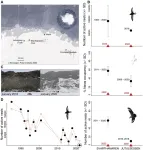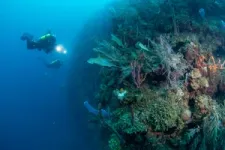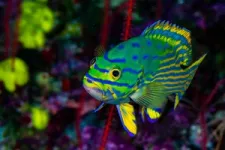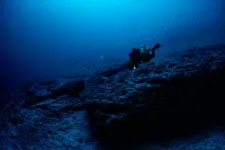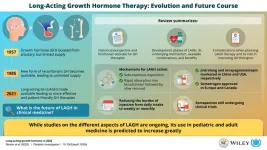(Press-News.org) The arrival of the new year is a prime time for Antarctic birds like the south polar skua, Antarctic petrel, and snow petrel to build nests and lay their eggs. However, from December 2021 to January 2022, researchers did not find a single skua nest on Svarthamaren, one of the regions where the birds go to raise their young. Similarly, the number of Antarctic petrel and snow petrel nests dropped to almost zero.
In these regions, climate change caused snowfall and snow accumulation to be significantly higher than in previous years. Now, a study published on March 13 in the journal Current Biology shows that these unusually strong snowstorms have interfered with the birds’ ability to breed.
“We know that in a seabird colony, when there’s a storm, you will lose some chicks and eggs, and breeding success will be lower,” says Sebastien Descamps, first author of the study and researcher at the Norwegian Polar Institute. “But here we’re talking about tens if not hundreds of thousands of birds, and none of them reproduced throughout these storms. Having zero breeding success is really unexpected.”
Svarthamaren and nearby Jutulsessen are home to two of the world’s largest Antarctic petrel colonies and are essential nesting grounds for snow petrels and south polar skua. From 1985 to 2020 in Svarthamaren, the colony contained between 20,000 and 200,000 Antarctic petrel nests, around 2,000 snow petrel nests, and over 100 skua nests annually.
In the 2021–2022 season, there were only three breeding Antarctic petrel, a handful of breeding snow petrels, and zero skua nests. Similarly, in Jutulsessen, there were no Antarctic petrel nests in summer of 2021 to 2022 despite previous years having shown tens of thousands of active nests.
“It wasn’t only a single isolated colony that was impacted by this extreme weather. We’re talking about colonies spread over hundreds of kilometers,” says Descamps. “So these stormy conditions impacted a really large part of land, meaning that the breeding success of a large part of the Antarctic petrel population was impacted.”
These birds lay their eggs on bare ground, so with enough snow, the ground becomes inaccessible, and chick-raising becomes impossible. The storms also have a thermoregulatory cost—the birds must spend their available strength sheltering, keeping warm, and conserving energy.
“Until recently, there were no obvious signs of climate warming in Antarctica except for on the peninsula,” says Descamps. “But in the last few years, there have been new studies and new extreme weather events that started to turn the way we see climate change in Antarctica.”
Descamps hopes that over time, the model used to predict storm severity can be adjusted to be even more accurate. “When it comes to storm severity, it’s both the wind and the snow accumulation,” he says. “There aren’t many places where we have the right kinds of snow measurements, and it plays an important role in explaining the breeding success of the birds.”
“I think our study shows in a very strong way that these extreme events do have a very strong impact on seabird populations, and climate models predict that the severity of these extreme events will increase,” says Descamps.
###
This study was supported by the Norwegian ministry of climate and environment (Klimaog miljødepartementet), the Region Nouvelle Aquitaine (France) through the ECOMM Excellence Chair and the Leverhulme Trust.
Current Biology, Descamps et al.: “Antarctic climate change: Extreme snowstorms lead to large-scale seabird breeding failures in Dronning Maud Land” https://www.cell.com/current-biology/fulltext/S0960-9822(22)01992-3
Current Biology (@CurrentBiology), published by Cell Press, is a bimonthly journal that features papers across all areas of biology. Current Biology strives to foster communication across fields of biology, both by publishing important findings of general interest and through highly accessible front matter for non-specialists. Visit http://www.cell.com/current-biology. To receive Cell Press media alerts, contact press@cell.com.
END
About The Study: In this study of 398,000 adult outpatients with COVID-19, the absolute risk of venous thromboembolism (VTE) was low. Several patient-level factors were associated with higher VTE risk; these findings may help identify subsets of patients with COVID-19 who may benefit from more intensive surveillance or VTE preventive strategies.
Authors: Margaret C. Fang, M.D., M.P.H., of the University of California, San Francisco, is the corresponding author.
To access the embargoed study: Visit our For The Media website at this link https://media.jamanetwork.com/
(doi:10.1001/jamanetworkopen.2023.2338)
Editor’s ...
BOSTON – Hypertension is the leading risk factor for death worldwide. During the COVID-19 pandemic, routine blood pressure assessments decreased because of global disruptions to medical care delivery. However, new research has found that a remote hypertension program, operated by Mass General Brigham since 2019, successfully supported patients through the pandemic in achieving their blood pressure goals, with patients who enrolled during the pandemic reaching and maintaining their goal blood pressures an average of two months earlier than in the pre-pandemic period. The results, published in Journal ...
How strongly a vaccine protects you may depend on getting enough sleep in the days before and after inoculation, finds a new meta-analysis examining the relationship between sleep duration and the body’s response to vaccination.
Sleeping fewer than six hours per night around the time of vaccination was associated with a robust decrease in antibody response, according to the multi-institution study published March 13 in Current Biology. Adults are typically recommended to get between seven and nine hours of sleep per night.
The meta-analysis included data on the association between sleep duration and antibody responses for the ...
In reviewing data from previous studies, a team lead by researchers at the University of Chicago and the French National Institute of Health and Medical Research (Inserm) found that individuals who had fewer than six hours of sleep per night in the days surrounding vaccination had a blunted antibody response. That indicates efforts to promote heathy sleep duration ahead of an immunization could be an easy way to improve vaccine effectiveness. The study was published March 13 in Current Biology.
The latest work builds off a 2002 study by members of the team showing that restricting sleep ...
While drugs are on the market to slow the progression of neurodegenerative diseases, there are still no cures. But researchers at Boston Children’s Hospital and Harvard Medical School are looking for new pathways for slowing neuronal dysfunction and treating amyotrophic lateral sclerosis (ALS), a fatal motor neuron disease. The team found that proteins involved in the innate immune system could be at the root of the disease.
“The unmet need for therapies for neurodegenerative diseases is huge, and our work opens up a whole new ...
SAN FRANCISCO, CA (March 13, 2023) — In a paper published today in Current Biology, researchers from the California Academy of Sciences Hope for Reefs initiative, along with Brazilian collaborators from the University of São Paulo, Federal University of Espírito Santo, and the Instituto Nacional da Mata Atlântica, show that mesophotic coral reefs function much differently than their shallower counterparts and are unlikely to offer a refuge for shallow water fishes trying to escape climate-change driven warming on the ocean’s surface.
The research is based on hundreds of dives totaling ...
Achieving the goals of the Paris Climate Agreement will require the combined efforts of states and companies around the world. How can developing countries achieve carbon neutrality and boost their resilience while pursuing economic growth and improved living standards? A study by the Research Institute for Sustainability (RIFS) draws on the example of Nepal to analyse the benefits of a net-zero emissions strategy.
Nepal is among the 10 countries most vulnerable to climate-change-related disasters and risks. However, its contribution to global greenhouse gas emissions is minor. As Nepal prepares to graduate ...
In 1957, Maurice Raben successfully isolated and purified the growth hormone (GH) from the pituitary gland, opening up a potential avenue of GH therapies. Children who were born with a deficiency of this hormone could now receive medical intervention in the form of daily injections to substitute the product into their body, thus avoiding the ill-effects of GH deficiency. However, given that it was a product that had to be meticulously extracted from the pituitary of dead bodies, and was time-consuming as well as labor- and resource-intensive process, it remained ...
Materials science is constantly evolving research area as researchers strive to discover and synthesize novel functional materials with desirable properties suited to a variety of applications. One example on this front is furnished by covalent organic frameworks (COFs), a class of materials characterized by crystalline porous polymers connected in the form of a network via covalent bonds.
Owing to their structural diversity, high porosity, and easily accessible active sites, COFs can be designed for a range of applications such as gas storage and separation, catalysis, and drug delivery. ...
Embargoed until 8:00 a.m. CT / 9:00 a.m. ET Monday, March 13, 2023
DALLAS and ALEXANDRIA, Va., March 13, 2023 — Health inequities can be detrimental to employees’ emotional, psychological and physical health and place a significant economic burden on employers. To improve employee well-being and reduce health inequities nationwide, the American Heart Association—a global force for longer, healthier lives for all—introduces the Health Equity in the Workforce initiative in collaboration with the Deloitte Health Equity Institute and the Society for Human Resource Management (SHRM) Foundation.
The Health Equity ...
